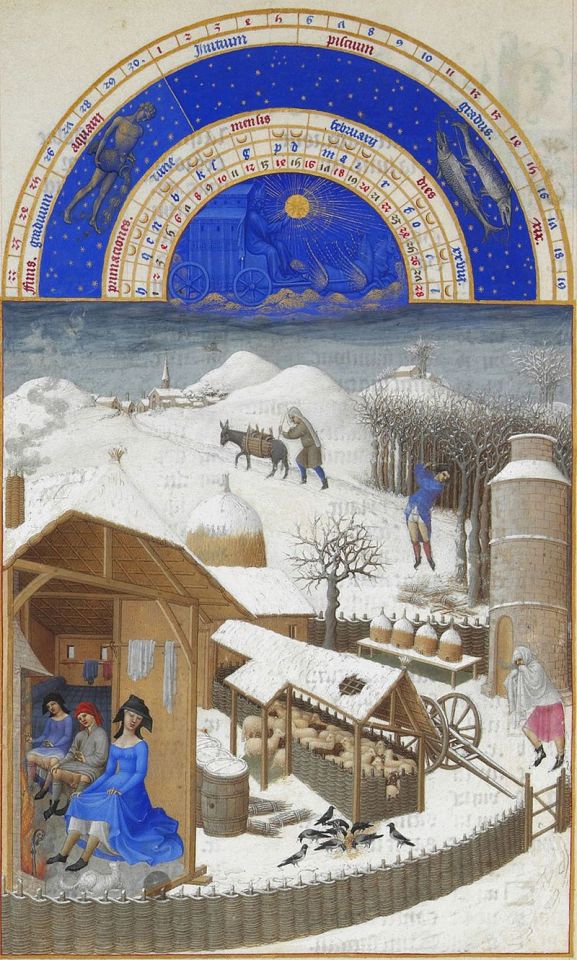#kale-monath
Text

the scrying mirror or winter wanes
yesterday was a difficult day and yesternight was a difficult night, but today already feels like something better. the last gasping grasp of the dark season, one hopes
this year i have decided to abandon the astronomical accounting of seasons and also happy last day of winter imaginary constructs
#every card is a promise#every card is a warning#looking#seeing#augury#mumblelard#mirrors#dutch ovens#leap day#kale-monath#beans#second blue moon epoch#first winter#and that would fix everything
38 notes
·
View notes
Text

> Before we adopted the Latin name for our second month, Old English used much more vibrant names to describe the month now known as February. The most common Old English name was Solmonath, which literally means “mud month.” (https://www.dictionary.com/e/february/)
> A lesser-used term was Kale-monath, which meant “cabbage month.” Perhaps, the medieval English were eating a lot of cabbage in February? Strange. (https://www.dictionary.com/e/february/)
Once February became an official month its name was changed. It was derived from the Roman festival of purification called Februa. In funny fashion the festival also gave birth to the Roman deity Februus. What is also interesting to note is that January and February were added months. Originally the calendar year was only 10 months but in 700BCE they were added by the second king of Rome to make the year match up more with how long it takes the Earth to complete it's rotation around the sun.
𝔽𝕖𝕓𝕣𝕦𝕒𝕣𝕪 ℂ𝕠𝕣𝕣𝕖𝕤𝕡𝕠𝕟𝕕𝕖𝕟𝕔𝕖𝕤
⚘ Animals: otter, unicorn, dragon, groundhog, deer, sheep, hares, rabbits
⚘ Birds: eagle, chicadee, robin
⚘ Celebrations: Imbolc (Feb 2), Candlemas (Feb 2), Disablot (Feb 2), Februa (Feb 15), Valisblot (Feb 9), Lupercalia (Feb 15), Parentalia (Feb 13-21), Quirinalia (Feb 17), Equirria (Feb 27), Fornicalia (Feb 17)
⚘ Colors: light blue, violet, pale green, black, red, pink
⚘ Deities: Alhrodite, Juno, Mars, Brighid, Kuan Yin, Diana, Demeter, Persephone, Sjofn, Apollo, Boann, Chang-O, Parvati, Venus, Shakti, Bast, Selene, Hebe, Eros, Pan, Branwen
⚘ Element: air, water
⚘ Flowers: balm of Gilead, hyssop, myrrh, sage, spikenard, primrose, viola, snowdrop
⚘ Gender: neutral
⚘ Herbs: cypress, cinnamon, lavender, patchouli, lemon, orange, sandalwood, rose, jasmine, ginger, clove, frankincense, ylang ylang, palma rosa, bay, mint, nettles, rosemary, thyme, oregano, balm of Gilead, hyssop, myrrh, sage and basil.
⚘ Magick Areas: purification, growth, healing, energy, self-love, accepting responsibility, self-forgiveness, making future plans, astral realm, banishing, beginning, empowerment, fertility
⚘ Moons: Snow Moon (Dakota), Racoon Moon (Dakota), Eagle Moon (Cree), Bear Moon (Ojibwe), Black Bear Moon (Tlingit), Groundhog Moon (Algonquin), Goose Moon (Haida), Bony Moon (Cherokee), Hungry Moon (Cherokee)
⚘ Sabbat: Imbolc (Feb 1-2)
⚘ Scents: wisteria, heliotrope
⚘ Spirits: house faeries (home and house plants)
⚘ Stones: amethyst, ammolite, angelite, garnet, jasper, imperial topaz, onyx, aquamarine, fluorite, turquoise, ruby, bloodstone, moonstone, obsidian, pearl and quartz
⚘ Trees: rowan, myrtle, laurel, cedar, cypress
⚘ Zodiac: Aquarius, Pisces
#occult#occultist#occultism#occultblr#pagan#paganism#paganblr#witch#witchcraft#witchblr#witch community#witches#spirituality#correspondences#february#discord
8 notes
·
View notes
Quote
Historical names for February include the Old English terms Solmonath (mud month) and Kale-monath (named for cabbage)
February - Wikipedia
1 note
·
View note
Note
Hello!
I would like to ask you about the months of the Diablo universe and the superstitions chained by them(the months) and the nephalem.
(I found nothing solid over the internet. I thaught about buying the books but, shipping from America to Europe is A FUCKING NIGHTMARE. Sidestory... I ordered some nice room decor things from the States but they got lost on the way to Europe and I never retrived them, nor my money. This is why I am asking around the internet )
Hullo hello
The main source of information on the months in Diablo is the Book of Adria. It is called the Anno Kehjistan calendar, and no information is given on how widely its used. The months are as follows:
Kathon, Solmoneth, Montaht, Ostara, Vasan, Lycanum, Kale Monath, Lunasadh, Jerharan, Damhar, Ratham, Esunar.
More under the cut, long post got long XP
We can get a sense of which months take place in which season as well. (I am assuming Sanctuary is a spheroid planet, like earth, and orbits a star, just to make life easier.)
Solmoneth and Montaht are months where "day and night are equal". Ergo, this would be one of the equinoxes, likely the winter one. Right after them is Ostara, the month of rebirth, followed by Vasan and Lycanum, the months of sowing and fertility. In other words, the end of spring, and beginning of summer. Lunasadh is the harvest month. From here we can hazard a guess about the rest of the months.
I would peg the seasons as being:
Winter: Esunar, Kathon, Solmoneth, Montaht
Spring: Ostara, Vasan
Summer: Lycanum, Kale Monath, Lunasadh
Fall: Jerharan, Damhar, Ratham
Notably, some of the seasons seem to be named after notable nephalem and angels. Esunar, Vasan, Lycanum, and Ratham would be Esu, Vasily, Lycander and Rathma, respectively. Kathon could also be a reference to Bul'Kathos.
Esunar is the month of elements, linking it nicely to Esu, the patron of the Zann-Esu/sorceress clans. Esu herself was a master of storm, earth, fire, and water.
Interestingly, Vasan and Lycanum are supposed to represent the duality between male and female, in addition to sowing and fertility. What exactly this has to do with Vasily and Lycander, and what they have to do with each other, is anyone's guess. Vasily is one name for the brother of Bul'Kathos and forebear of the druids. Lycander was the angel who fell in love with a nephalem, and went on to become part of the amazon pantheon. The two don't exactly have much relation, and Vasily may have been retconned out of existence.
Gotta love Diablo Lore.
Like Esunar, Ratham is a month easily linked back to its namesake. It is the so called month of the dead, likely the equivalent of real-world October. Summoning and binding is easier during this month. Aptly named, for Rathma was a summoner and binder of the dead.
Aside from the slight similarity in name, there's not much linking Kathon to Bul'Kathos. It is a month of destruction, and honors Baal more than anything. Interestingly, the month is sandwiched between Esunar and Ratham, the other two ancient nephalem months.
It is a personal head-canon of mine that the nephalem were born in the months they're named after - there is no canonical base for this though. Lots of winter birthdays.
This page talks in a little more detail about the months - finding it was kinda tricky. I believe the wiki is still undergoing a restructure right now, makes information digging a bit harder.
And if you have the receipts for your order, def keep pestering the seller. If they can't get you your order, you should get a refund. Good luck friend!
9 notes
·
View notes
Photo

#fevereiro #purificação #lua #februarius #february #lunar #februum #luacheia #moon #calendariolunar #calendario #decenviros #estaçõesdoano #mêsdefevereiro #mês #gelo #sãovalentim #chocolates #februa #perola #lama #madeira #significado #significadomes #shreembrzee #krsna #krishna #derivadodapalavra https://en.wikipedia.org/wiki/February FEVEREIRO em Inglês FEBRUARY Derivado da palavra latina, o mês romano Februarius foi nomeado após o termo latino februum , que significa "PURIFICAÇÃO", através do ritual de purificação Februa realizado em 15 de fevereiro (lua cheia) no antigo calendário lunar romano . Janeiro e fevereiro foram os últimos dois meses a serem adicionados ao calendário romano, já que os romanos originalmente consideravam o inverno um período sem meses. Eles foram adicionados por Numa Pompílio por volta de 713 aC. Fevereiro permaneceu o último mês do ano civil até a época dos decênviros (c. 450 aC), quando se tornou o segundo mês. Em certos momentos fevereiro foi truncado para 23 ou 24 dias, e um mês intercalar de 27 dias, Intercalaris, foi ocasionalmente inserido imediatamente após fevereiro para realinhar o ano com as estações do ano . Os nomes históricos de fevereiro incluem os termos em inglês antigo Solmonath (mês da lama) e Kale-monath (nomeado para repolho ), bem como a designação de Carlos Magno Hornung. Em finlandês, o mês é chamado helmikuu , que significa "mês da pérola" ; quando a neve derrete nos galhos das árvores, ela forma gotículas e, à medida que elas congelam novamente, são como pérolas de gelo. Em polonês e ucraniano , respectivamente, o mês é chamado de luty ou лютий ( lyutiy ), significando o mês do gelo ou geada forte. Em macedônio o mês é sechko ( сечко), significando mês de (madeira). Em tcheco, é chamado únor , que significa mês de submersão (do gelo do rio). (em Vila Industrial, São Paulo-Sp) https://www.instagram.com/p/CZckMhwv5oHcIzcqFBT-82G3T--t5nYxW6r2js0/?utm_medium=tumblr
#fevereiro#purificação#lua#februarius#february#lunar#februum#luacheia#moon#calendariolunar#calendario#decenviros#estaçõesdoano#mêsdefevereiro#mês#gelo#sãovalentim#chocolates#februa#perola#lama#madeira#significado#significadomes#shreembrzee#krsna#krishna#derivadodapalavra
0 notes
Photo



February
February, from the Très riches heures du Duc de Berry
February is the second month of the year in the Julian and Gregorian calendars, with 28 days in common years and 29 days in leap years, with the quadrennial 29th day being called the leap day. It is the first of five months to have fewer than 31 days (the other four being April, June, September, and November) and the only one to have fewer than 30 days. The other seven months have 31 days. In 2020, February has 29 days.
February is the third and last month of meteorological winter in the Northern Hemisphere. In the Southern Hemisphere, February is the third and last month of summer (the seasonal equivalent of August in the Northern Hemisphere, in meteorological reckoning).
The Roman month Februarius was named after the Latin term februum, which means purification, via the purification ritual Februa held on February 15 (full moon) in the old lunar Roman calendar. January and February were the last two months to be added to the Roman calendar, since the Romans originally considered winter a monthless period. They were added by Numa Pompilius about 713 BC. February remained the last month of the calendar year until the time of the decemvirs (c. 450 BC), when it became the second month. At certain times February was truncated to 23 or 24 days, and a 27-day intercalary month, Intercalaris, was occasionally inserted immediately after February to realign the year with the seasons.
February observances in Ancient Rome included Amburbium (precise date unknown), Sementivae (February 2), Februa (February 13–15), Lupercalia (February 13–15), Parentalia (February 13–22), Quirinalia (February 17), Feralia (February 21), Caristia (February 22), Terminalia (February 23), Regifugium (February 24), and Agonium Martiale (February 27). These days do not correspond to the modern Gregorian calendar.
Under the reforms that instituted the Julian calendar, Intercalaris was abolished, leap years occurred regularly every fourth year, and in leap years February gained a 29th day. Thereafter, it remained the second month of the calendar year, meaning the order that months are displayed (January, February, March, ..., December) within a year-at-a-glance calendar. Even during the Middle Ages, when the numbered Anno Domini year began on March 25 or December 25, the second month was February whenever all twelve months were displayed in order. The Gregorian calendar reforms made slight changes to the system for determining which years were leap years, but also contained a 29-day February.
Historical names for February include the Old English terms Solmonath (mud month) and Kale-monath (named for cabbage) as well as Charlemagne's designation Hornung. In Finnish, the month is called helmikuu, meaning "month of the pearl"; when snow melts on tree branches, it forms droplets, and as these freeze again, they are like pearls of ice. In Polish and Ukrainian, respectively, the month is called luty or лютий ("lyutiy"), meaning the month of ice or hard frost. In Macedonian the month is sechko (сечко), meaning month of cutting (wood). In Czech, it is called únor, meaning month of submerging (of river ice).
In Slovene, February is traditionally called svečan, related to icicles or Candlemas.[2] This name originates from sičan, written as svičan in the New Carniolan Almanac from 1775 and changed to its final form by Franc Metelko in his New Almanac from 1824. The name was also spelled sečan, meaning "the month of cutting down of trees".
In 1848, a proposal was put forward in Kmetijske in rokodelske novice by the Slovene Society of Ljubljana to call this month talnik (related to ice melting), but it did not stick. The idea was proposed by a priest, Blaž Potočnik. Another name of February in Slovene was vesnar, after the mythological character Vesna.
https://en.wikipedia.org/wiki/February
0 notes
Photo

Historical names for February include the Old English terms Solmonath (mud month) and Kale-monath (named for cabbage) as well as Charlemagne's designation Hornung. I can guess where the cabbage thing comes from but what about Hornung? Any ideas? . . . . . . . . . . . . . . . . . . . . #makersworkshop #sustainableproducts #freestylecreativeliving #cozyvibes #faschionstyle #ecolifestyle #everydayisearthday #createmakeshare #comfortableshoes #dreamjobmakers #liveautentic #greenhome #naturallifestyle #buydifferently #contemporarycraft #ecofriendlyproducts #handmadelife #makersgunnamake #seasonschange #homeinthestudio #shoestyle #zerowastecollective #woolenclogs #etsylithuania
#makersworkshop#buydifferently#seasonschange#liveautentic#etsylithuania#everydayisearthday#faschionstyle#greenhome#contemporarycraft#sustainableproducts#ecolifestyle#handmadelife#dreamjobmakers#homeinthestudio#comfortableshoes#shoestyle#naturallifestyle#cozyvibes#freestylecreativeliving#ecofriendlyproducts#makersgunnamake#woolenclogs#zerowastecollective#createmakeshare
0 notes
Photo

#fevereiro #purificação #lua #februarius #february #lunar #februum #luacheia #moon #calendariolunar #calendario #decenviros #estaçõesdoano #mêsdefevereiro #mês #gelo #sãovalentim #chocolates #februa #perola #lama #madeira #significado #significadomes #shreembrzee #krsna #krishna #derivadodapalavra https://en.wikipedia.org/wiki/February FEVEREIRO em Inglês FEBRUARY Derivado da palavra latina, o mês romano Februarius foi nomeado após o termo latino februum , que significa "PURIFICAÇÃO", através do ritual de purificação Februa realizado em 15 de fevereiro (lua cheia) no antigo calendário lunar romano . Janeiro e fevereiro foram os últimos dois meses a serem adicionados ao calendário romano, já que os romanos originalmente consideravam o inverno um período sem meses. Eles foram adicionados por Numa Pompílio por volta de 713 aC. Fevereiro permaneceu o último mês do ano civil até a época dos decênviros (c. 450 aC), quando se tornou o segundo mês. Em certos momentos fevereiro foi truncado para 23 ou 24 dias, e um mês intercalar de 27 dias, Intercalaris, foi ocasionalmente inserido imediatamente após fevereiro para realinhar o ano com as estações do ano . Os nomes históricos de fevereiro incluem os termos em inglês antigo Solmonath (mês da lama) e Kale-monath (nomeado para repolho ), bem como a designação de Carlos Magno Hornung. Em finlandês, o mês é chamado helmikuu , que significa "mês da pérola" ; quando a neve derrete nos galhos das árvores, ela forma gotículas e, à medida que elas congelam novamente, são como pérolas de gelo. Em polonês e ucraniano , respectivamente, o mês é chamado de luty ou лютий ( lyutiy ), significando o mês do gelo ou geada forte. Em macedônio o mês é sechko ( сечко), significando mês de (madeira). Em tcheco, é chamado únor , que significa mês de submersão (do gelo do rio). (em Vila Industrial, São Paulo-Sp) https://www.instagram.com/p/CZci32avU4T4CTzjghjpsHakEUINFD33BG8Hg80/?utm_medium=tumblr
#fevereiro#purificação#lua#februarius#february#lunar#februum#luacheia#moon#calendariolunar#calendario#decenviros#estaçõesdoano#mêsdefevereiro#mês#gelo#sãovalentim#chocolates#februa#perola#lama#madeira#significado#significadomes#shreembrzee#krsna#krishna#derivadodapalavra
0 notes